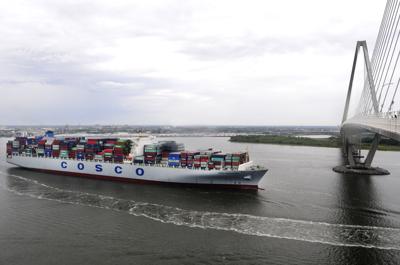Charleston's harbor pilots, the people responsible for safely guiding commercial vessels to and from the Port of Charleston, say they plan to evaluate their operations following the March 26 incident in Baltimore in which a bridge collapsed after being hit by a containership.
"Our entire maritime and logistics community works together every day to safely move freight," Crayton Walters, president of the Charleston Branch Pilots Association, said in a written joint statement with South Carolina transportation and ports leaders.
Walters said the agencies "have already had initial conversations regarding the incident," and will jointly review harbor operations, procedures and state infrastructure.
“Our thoughts and prayers are with those in Baltimore today impacted by this tragic incident," he said. "Like everyone in the maritime industries, we are standing by for details of what the causal factors of this incident were. Harbor pilots nationwide are highly trained, undergo emergency ship handling training and receive extensive continuing education on a regular basis, including simulation training for emergency scenarios.”
Harbor pilots guide containerships and other vessels, such as cruise ships, through the entrance channel to the Port of Charleston, and their knowledge of local waterways — including depths, currents and potential hazards — can be invaluable to containership crews who may never have experienced the harbor before.
In Charleston, there are 20 licensed harbor pilots who work a week-on, week-off schedule but no more than 12 hours without a rest period. They can be dispatched 24 hours a day, seven days a week from their headquarters building, which includes sleeping quarters and eating facilities, at 6 Concord St.
A pilot typically will ride one of the agency's four pilot launch vessels out to sea to meet a containership as far as 20 miles off the coast. The smaller vessel will pull alongside a containership and then the pilot will board the larger vessel by jumping onto a waiting rope ladder. The pilot will then be escorted to the containe ship's bridge, where the pilot will conduct a brief inspection to ensure safety and become acquainted with the ship's captain and senior crew.
The pilot — with the assistance of high-tech navigational equipment and personal experience — then gives orders to steer the containership into the entrance channel, through Charleston Harbor and toward the appropriate terminal berth. Tugboats usually join alongside near the Ravenel Bridge to help the containership maneuver into place.
When containerships depart, harbor pilots provide the same service in reverse.
State law requires a pilot on all foreign-registered vessels, and U.S.-registered vessels that are engaged in international trade and with a draft greater than 11 feet.
South Carolina law requires applicants for a Charleston Harbor pilot's license to have either a four-year degree or a third mate's merchant mariner's license issued by the Coast Guard. They also must have satisfactory eyesight, hearing and physical fitness, and must complete a three-year apprenticeship with Charleston Branch Pilots. Pilots then go through the process of working bigger ships until they are ready for the large container vessels that regularly call on the port. All told, it can take seven years to become a full-fledged harbor pilot.
South Carolina's harbor pilots hold both a federal license, issued by the Coast Guard, and a state license, issued by the S.C. Commissioners of Pilotage. To maintain a license, a pilot must submit to random drug screening and an annual physical exam. Federal licenses must be renewed every five years.










